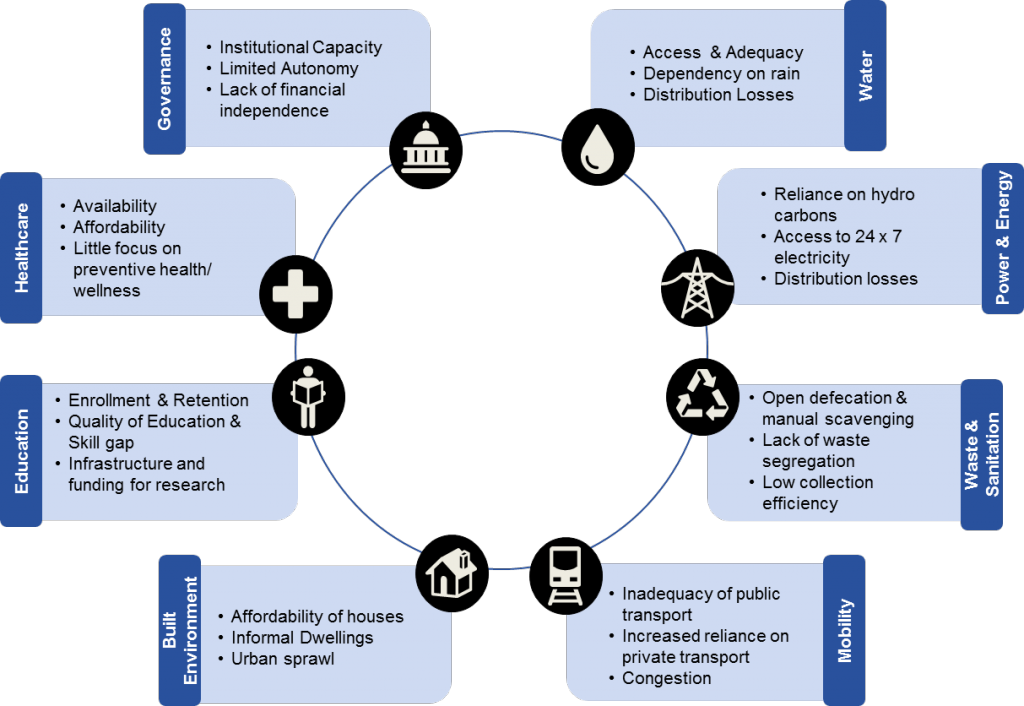Context
-
Over 34% of India’s current population lives in urban areas, rising by 3% since 2011.
-
Cities require a renewal that factors in rural-urban migration
Current Status:
-
While existing large urban agglomerations (those with a population above 50 lakh) have remained mostly constant in number since 2005, smaller clusters have risen significantly (from 34 to 50 clusters with 10-50 lakh population).
-
By some estimates, India’s urban population could increase to 814 million by 2050.
-
With an increase in urban population will come rising demands for basic services such as clean water, public transportation, sewage treatment and housing.
Schemes like Smart City Analysis:
-
While over 90 ‘Smart Cities’ have identified 2,864 projects, India lags on implementation, with about 148 projects completed and over 70% still at various stages of preparation.
-
There is still an outstanding shortage of over 10 million affordable houses despite the government taking encouraging steps to incentivise their construction.
How Urban is defined?
-
Urban development comes under State governments, with the Governor notifying an area as urban based on parameters such as population, density, revenue generated for the local administration and percentage employed in non-agricultural activities.
-
This notification leads to the creation of an urban local government or municipality, classifying the area as a “statutory town”.
-
The Central government considers a settlement as urban :
-
If it has a urban local government, a minimum population of 5,000;
-
Over 75% of its (male) population working in non-agricultural activities; and
-
A population density of at least 400 per sq. km.
-
-
However, many States consider such “census towns” as rural, and establish governance through a rural local government or panchayat.
Urban India’s challenges
-
Examples:
-
Recurring instances of floods in Mumbai,
-
Dengue in Delhi.
-
Lakes on fire in Bengaluru paint a grim picture.
-
While work continues slowly, on the Delhi-Mumbai Industrial Corridor project and the bullet train. etc
-
-
Urban infrastructure investment and capacity building : India spends about $17 per capita annually on urban infrastructure projects, against a global benchmark of $100 and China’s $116.
-
Announcing a variety of schemes, the Jawaharlal Nehru National Urban Renewal Mission included, but implementation has been mostly inadequate, with exploration of financing options limited as well.
Systemic policy to deal with urban migration
-
Internal migration in India is very closely linked to urban transitions, with such migration helping reduce poverty or prevent households from slipping into it. Urban migration is not viewed positively in India, with policies often bluntly seeking to reduce rural to urban migration.
-
Preventing such migration can be counterproductive — it would be better to have policies and programmes in place to facilitate the integration of migrants into the local urban fabric, and building city plans with a regular migration forecast assumed.
-
Lowering the cost of migration, along with eliminating discrimination against migrants, while protecting their rights will help raise development across the board.
Way Forward:
-
We need to empower our cities, with a focus on land policy reforms, granting urban local bodies the freedom to raise financing and enforce local land usage norms. For an India to shine, the transformation of its cities is necessary.

Source: